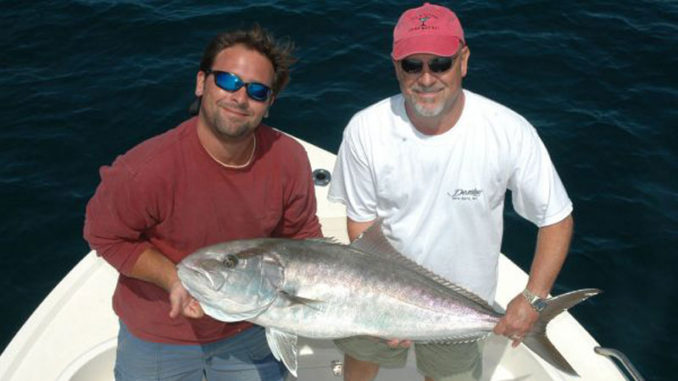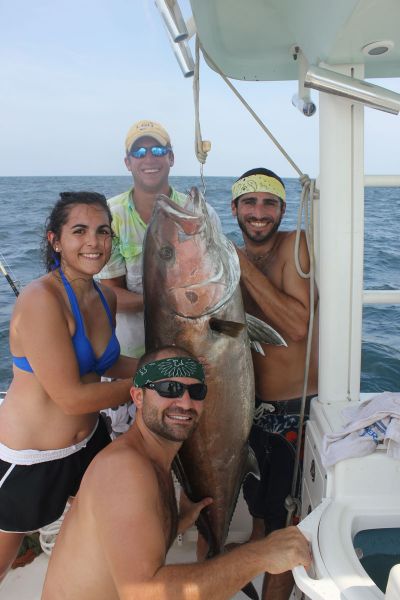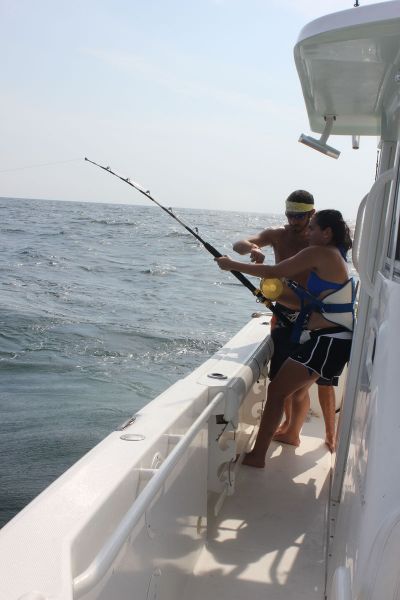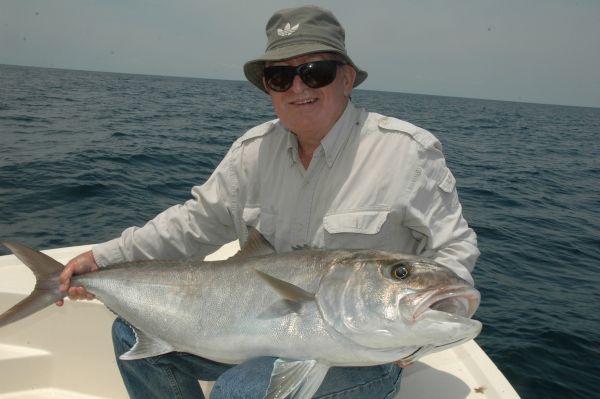
These brothers love to tangle with one of the hardest-fighting fish in the Gulf. Here’s how they make quick work of amberjack.
I had never caught an amberjack before, and I must say that I vastly underestimated their brutality.
Sometimes referred to as “tuna on steroids,” I soon found out these brutes can take you for a wild ride early on in the fight, even though they quickly tire into submission.
But that fight leaves the angler and the fish exhausted.
I was fortunate enough to be the guest of a duo of hardcore offshore fanatics affectionately known in the Grand Isle area as “the Tobler boys.”

Twenty-six-year-old Jonathan Tobler would captain the boat, and his 30-year-old brother, Chad, would be the fish master for the day, rigging and setting baits and giving knowledgeable advice to the amberjack rookies onboard.
This sibling tag team grew up spending their summers at Grand Isle, first pursuing inshore species and then venturing into the open Gulf of Mexico in pursuit of offshore fish, which is now their passion.
During my trip, it became apparent how well they work together, methodically anticipating each other’s moves. Their work was occasionally interrupted by brief but intense outbursts on points of disagreement, but these were quickly forgotten — just a sibling rivalry between two perfectionists passionate about their sport.
The day began well before dawn as the crew emerged from the Tobler’s “Big Easy” camp, scurrying around to gather the equipment, food, drinks and supplies needed for a full day offshore.
After a quick drive to Sand Dollar Marina and loading up provisions and ice, we were off in the 29-foot Everglades as the eastern horizon began to brighten.
“Are you ready for some hardcore fishing?” Jonathan shouted over the blaring music as we passed the beach and hit the smooth Gulf waters. “We go all day until dark. We fish hard and go as far as we need to go. There is no quit in us.”
I nodded and silently began to question if I really wanted to do this. I normally pursue trout in the quiet coastal waters, returning in the early afternoon with enough time for a nap before dinner.
This was not going to be that kind of trip.
On the way out, Chad spoke about his passion for offshore fishing.
“I learned from experience, mainly fishing with friends and other charter captains prior to my family getting an offshore boat,” he said. “I’m also a student of fishing, reading whatever literature I can get my hands on from reputable sources.”
I asked about what I could expect on this trip, and he excitedly replied.
“We’re mainly going after (amberjacks) today,” Chad said. “The thing I like about AJs is that they bite really well once you locate them. They fight like a mule — that’s why we call them ‘rig donkeys’ — but they wear out after about 10 or 15 minutes.”

He said rigging up for effective amberjack hunting is pretty straightforward.
“We’ll be using very heavy gear and live hardtails for bait, and will be fishing in water between 300 to 400 feet deep,” Chad said. “Normally, the AJs are between 175 to 250 feet down, but we’ll be using our sonar to find the exact depth.
He said the key is keeping them from breaking off.
“Amberjack hit like freight trains and head straight for the rig,” Chad explained. “You have to pull the fish off of the rig with the boat where you can fight them.
“If they make it to rig, it’s game over.”
As he was speaking, the boat slowed as we approached some rigs southeast of Barataria Pass in water about 100 to 170 feet deep.
“Time to catch some hardtails, so let’s get the sabiki rigs out,” Jonathan announced.
His brother sprang into action, rigging two spinning rods with sabiki rigs, handing them to me and another guest on board.
“Just cast it out and start jigging hard,” he said.
I did so and soon had two lively hardtails going into the live well. We put about 20 hardtails in the live well before heading south.
I made my way over to the helm for a brief chat with Jonathan about boat handling for offshore fishing.
“Boat handling is everything, especially with AJs,” the captain said. “It’s not like snapper fishing, where you just hook on to a rig. You have to be mobile and be ready to pull the AJ off the rig with the boat after you hook up.”
But there is more involved than that — and it begins even before lines are dropped.
“When you approach a rig that’s holding amberjack that you’ve spotted on the sonar, you have to determine how the current is running so you can position the boat close enough to the rig to get your bait in the strike zone but not too close so the fish is already under the rig when you hook it,” Jonathan said. “It takes experience to learn how to fine-tune boat handling, but it’s the key to catching and landing AJ’s.”

Our first stop was a rig in about 300 feet of water where big red snapper were so thick they ate our hardtails before any AJs could get to them.
So the Tobler boys had a short conference and decided to head to the Midnight Lump, where there were some good reports of AJs.
Plan B was soon to be executed.
The ride to the Lump was not a short one from Grand Isle, and there were no guarantees. As we arrived, we saw a handful of boats, and it looked like one was hooked up.
Chad quickly had a hardtail rigged and dispatched. After the desired depth was reached, he put the rod in the holder.
“Watch that rod,” he told me.
It wasn’t long before there were a couple of hard jerks, followed by the rod tip nearly bending into the water.
“He’s on!” Jonathan screamed, putting the boat in gear.
I had already put the fighting belt on, and Chad instructed me to grab the rod.
As I did, I felt the unbridled power of this fish. I almost felt that he would pull me overboard. I straightened my back and took a few steps backwards before another powerful run.
“Hold on!” the Tobler boys bellowed with toothy smiles and wicked chuckles.
Before long, the runs became less frequent and shorter in duration.
As sweat poured off of me and my muscles trembled, the fish finally lost the will to fight and was quickly gaffed.
It was a roughly 60-pound amberjack.
“Another AJ virgin bites the dust,” Jonathan chanted, dancing around the boat, before rolling the fish into the fish box.
The action was steady while drifting on the Lump, and all of the guests were able to put an AJ in the fish box.
But the day was still young, so the Tobler boys decided to head for the rip, which was about 53 miles out from Barataria Pass, to try to catch some mahimahi.
I had never been out to the blue water off the Louisiana coast, and I saw for myself how incredibly beautiful the crystal-clear waters are.
This rip had lots of grass in it and the mahimahi were everywhere. We used spinning gear baited with squid, and it was an absolute feeding frenzy.
I have been on some awesome trout bites, but nothing compared to this. We caught as many as we wanted and then took a break to eat lunch.
A few guests on board couldn’t resist the urge to take a dip in the warm cobalt-blue Gulf waters to escape the mid-day heat.

The ride back to Grand Isle seemed much longer than the trip out, but the Tobler boys were not ready to call it a day.
“How about some mangroves?” Jonathan asked.
I was starting to like this offshore stuff.
A brief stop at some shallow water rigs yielded some mangrove snapper, which nicely topped off the fish box filled with the AJs and mahimahi.
These fish would provide some great meals during the fall and winter months.
With daylight fading, we made the final turn into the marina after traveling about 150 miles round-trip. We were exhausted but satisfied with the great day we had on the water.
“I told you that we fish hard,” Jonathan Tobler said.
Rigging up for Amberjack
Chad Tobler and Capt. Damon McKnight agree that heavy tackle is critical when it comes to amberjack fishing, and a common mistake of inexperienced AJ anglers is to go too light.
 Here are these anglers’ setups:
Here are these anglers’ setups:
• Tobler — Penn International 50W or 80W reels spooled with 150- or 200-pound mono and the stiffest rod (i.e., tuna rod) you can find. He builds Carolina-rigs with 200-pound mono leader and various egg sinker weights (depending on current), but 8-ounce weights are normally used.
He finishes off the rig with triple-strong 8/0 circle hooks.
And don’t forget the stand-up fighting belt.
• McKnight — Shimano TLD 50 reels spooled with 250-pound mono and Shimano Tallus 80-130 rods. His Carolina rigs include 400-pound mono leaders and 32-ounce weights tipped with 13/0 circle hooks.
Capt. Damon McKnight’s AJ secrets
Super Strike Charters’ Capt. Damon McKnight shared some of the secrets he’s learned during his 25 years of battling amberjack out of his Venice headquarters.
Here are his thoughts:
Q: What do you like about amberjack fishing compared to other offshore species?
A: They are not very finicky most days and put up a great fight for customers. They also are very good to eat.
Q: How do amberjack fight compared to tuna?
A: An 80-pound tuna is a good fight to the end; that means a tuna will stay consistent throughout the fight.
An 80-pound amberjack puts up an unbelievable fight for the first five minutes — after that, they start to wear out.
It is critical to get the fish up quick or he will usually get you wrapped up in something and break you off.
But, for the first five minutes, that 80-pound AJ has a yellowfin tuna beat, for sure.
Q: In what area do you stop to catch hardtails for bait? Block number and depth of water? How many should you catch for bait? Can other baits be used?
A: We fish hardtails on any rig, rip, or buoy that might be holding them. It can be any block number, usually in 400 feet or less.
Fishing AJ’s with live bait can be quick some days, and it can take a while if there are other fish down there such as barracuda or sharks.
A good number to have is about 30 hardtails for amberjack. They should be on the larger size, about a pound or larger.
Other baits that you can use are jigs: Any type of diamond jig or metal jig will usually work if they are thick.
We have caught them trolling Stretch 30’s and Rapalas, as well.
Q: What is the best depth of water to fish for amberjack? Block numbers?
A: The best depth is around 300 feet. You can fish any rig in those depths in any block from Main Pass, South Pass, and West Delta.
Q: How deep should you go down with your bait? How can you tell?
A: Go down to 150 feet or better. You do not have to be exact on depth; however, you can mark your line in 20-foot increments by using a permanent marker or using colored tape.
Q: Is there a particular technique used to get them to bite (i.e. jigging up and down, etc.)?
A: No technique is really necessary for live bait. You just have to get it down to them.
For jigging it will take a fair amount of movement most days, but it has to be balanced. Most people barely bounce the jig, and do more reeling up and down than bouncing. So, there is some technique that has to apply in order to get the best bite.
 Q: What general area do you fish/catch most of the amberjack?
Q: What general area do you fish/catch most of the amberjack?
A: We catch them in all of the West Delta, Main Pass, and South Pass blocks. We do better fishing in an area that has weaker current and clean water.
Amberjack schools do move from rig to rig, so you will usually have to do a little searching.
Q: What mistakes do most people make when fishing for amberjack?
A: The biggest mistake is not using heavy-enough tackle. The sure thing is to use the bigger stand-up equipment, with 250-pound test and big hooks.
They are a powerful fish, so you really have to work to get them away from structure.
Q: What are some other things that people should know about fishing for amberjack?
A: Be ready to lose a lot of tackle if you are not prepared. Do not show up with 80-pound PowerPro on a small rod and reel with a couple of jigs: You will surely lose most fish that you hook.
Go with the heavy tackle, and once you are hooked up have the captain or person behind the wheel pull away from the rig or reef to give you a better chance of getting the fish than losing him.
It will take some practice to get it figured out perfectly, but the key is to go heavy; they usually aren’t line shy.
Editor’s note: McKnight can be reached at can be reached at 800-318-1720 or www.superstrikescharters.com.